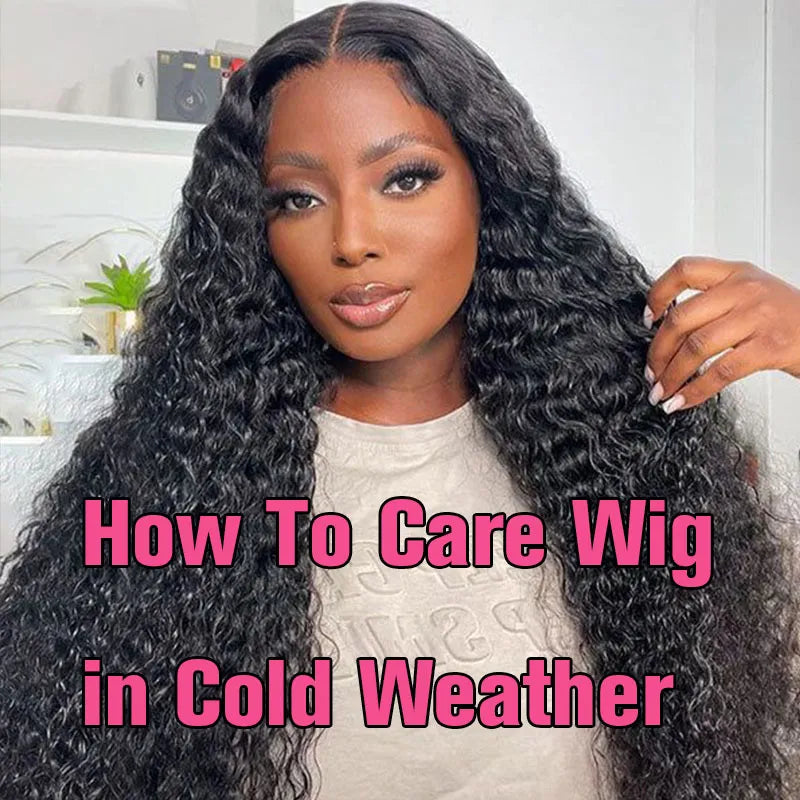
How To Care Wig in Cold Weather
As the chilly temperatures set in, taking care of your wigs becomes crucial to ensure they maintain their luster and longevity. Cold weather can pose unique challenges for wig maintenance, from combating dryness to preventing static. Here are some valuable tips to keep your wigs looking fabulous throughout the winter season.
How Does Cold Weather Affect Wigs
Cold weather can make human hair wigs dry, brittle, and more prone to tangling. The low humidity levels can strip away natural moisture, leading to changes in texture and a potential loss of shine. Protective measures, such as moisturizing and avoiding extreme conditions, are essential to maintain the quality of human hair wigs in cold weather.

How To Care Wig in Cold Weather
Caring for a human hair wig during the cold season is crucial to maintain its quality and appearance. Here are some tips to keep your human hair wig in excellent condition in colder weather:
-
Hydration and Moisture:
-
Cold weather often means low humidity, which can lead to dryness. Keep the hair moisturized by using a leave-in conditioner or a specialized wig conditioning spray. This helps prevent the hair from becoming brittle and prone to breakage.
-
-
Gentle Washing:
-
Limit the frequency of washing your wig in cold weather to prevent over-drying. When you do wash it, use a sulfate-free and moisturizing shampoo. Follow with a conditioner to keep the hair hydrated.
-
-
Avoid Excessive Heat Styling:
-
Cold weather can make the hair more vulnerable to damage. Minimize the use of heat styling tools, and if you must use them, apply a heat protectant to prevent excessive dryness and breakage.
-
-
Protective Hairstyles:
-
Consider wearing protective hairstyles that keep the ends of the wig covered. This helps shield the hair from harsh weather conditions and minimizes exposure to the elements.
-
-
Use Silk or Satin Scarves and Pillowcases:
-
Wrap your wig in a silk or satin scarf when you're out in the cold or sleeping. These materials are gentler on the hair and help prevent friction, reducing the risk of tangling and breakage.
-
-
Avoid Wet Conditions:
-
Human hair wigs, like natural hair, can be affected by moisture. If it's snowing or raining, use an umbrella or wear a hat to protect the wig from getting wet. Wet hair can lead to tangling and damage.
-
-
Regular Brushing:
-
Gently brush the wig regularly with a wide-tooth comb or a wig brush to prevent tangling. Start from the tips and work your way up to the roots, holding the hair at the base to avoid pulling on the knots.
-
-
Store Properly:
-
When not in use, store your human hair wig on a wig stand in a cool, dry place. Avoid exposing it to extreme temperatures or leaving it in a cold car.
-
-
Deep Conditioning Treatments:
-
Periodically, treat your wig to deep conditioning treatments to restore moisture and keep the hair soft and manageable.
-
-
Trimming:
-
Regular trims help keep the ends of the wig healthy and prevent split ends. This is especially important during colder weather when the hair is more prone to dryness.
-
-
Professional Maintenance:
-
If you're unsure about caring for your human hair wig during the cold season, consider consulting a professional wig stylist for advice or maintenance services.
-
By incorporating these tips into your wig care routine, you can help protect your human hair wig from the effects of cold weather and maintain its beautiful and natural look.
Common Mistakes People Make When Washing the Wig In Cold Weather
-
Using Hot Water:
-
It's a mistake to use hot water when washing wigs in cold weather. Hot water can strip the hair of natural oils and exacerbate dryness, leading to a brittle texture.
-
-
Skipping Conditioning:
-
Cold weather often means low humidity, which can contribute to dryness. Skipping the conditioning step after washing can leave the wig more prone to frizz and tangling.
-
-
Not Detangling Before Washing:
-
Failing to detangle the wig before washing can lead to increased tangling during the washing process. Gently comb or brush through the hair to remove any knots before washing.
-
-
Rubbing Vigorously:
-
Vigorous rubbing or scrubbing during the washing process can cause friction and lead to tangling. Instead, gently cleanse the wig, moving in a downward motion to prevent unnecessary friction.
-
-
Using Regular Shampoo:
-
Using regular shampoo designed for natural hair may contain harsh ingredients that can strip the wig's synthetic or human hair strands. Opt for a wig-specific shampoo that is gentle and moisturizing.
-
-
Not Allowing Proper Drying Time:
-
In cold weather, it might take longer for the wig to air dry. Ensure the wig is completely dry before storing or styling to prevent mold and odors.
-
-
Using Heat Excessively:
-
In an attempt to dry the wig quickly, using excessive heat from hairdryers or other styling tools can cause damage, especially in cold weather when the hair is more vulnerable.
-
-
Not Protecting the Wig during Outdoor Activities:
-
If you wear the wig outdoors during or after washing, be cautious of wind, snow, or rain. Wet or damp hair is more susceptible to tangling and damage.
-














